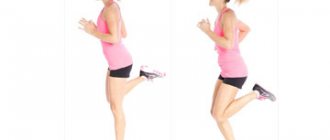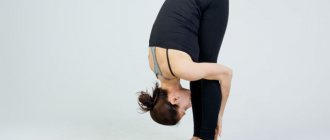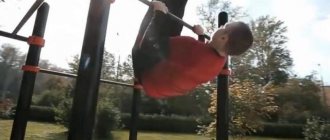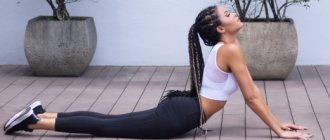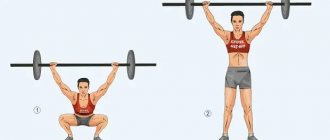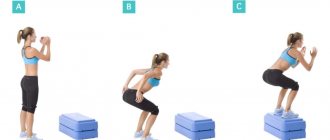Paripurna Navasana pose photo Complete or complete means Paripurna, and Navasana translates as boat. Accordingly, the complete asana is called the completed (full) boat pose. Refers to the second degree of complexity.
Contraindications: cardiovascular diseases, acute intestinal disorders and diseases, diarrhea.
Execution technique
Step 1:
Sit on the floor, stretch your legs straight in front of you (Dandasana - staff pose).
Press your hands with your palms toward the floor slightly behind your hips, with your fingers pointing toward your legs.
If necessary, use your hands to move your buttocks to the sides and back and release your sit bones. Sit on the space between your sit bones and your tailbone.
Step 2:
Lift your chest, tighten your shoulder blades.
Exhale and begin to tilt your body back a little (about 50-60 degrees), while lifting both legs off the floor.
Make sure your back is straight and not rounded. Avoid arching your lower back.
Curl your tailbone toward the floor and pull your pubis toward your navel.
If possible, slowly straighten your knees, raising your toes just above eye level. If this is not possible, keep your knees slightly bent.
Step 3:
Extend your arms straight next to your legs, parallel to each other and the floor. Palms turned inward. Shoulders and palms should be in line.
Step 4:
The whole body balances on the buttocks. Keep your back, legs and arms straight and taut.
Keep your lower abdomen taut , do not protrude it forward (do not inflate it).
Place your body weight more firmly on your sit bones to secure the pose and lift your chest higher.
Pull your chin slightly towards your chest, do not throw your head back.
Step 5:
To begin, stay in the pose for 10-20 seconds. Gradually increase the time you hold the pose to 1 minute.
The essence of Boat pose in yoga
In the literature there is a description of two versions of this position: a full or completed boat - paripurna navasana and half a boat - ardha navasana. They have a strong effect, but act on different organs.
A full boat acts more on the intestines, and half on the gallbladder. Differences in effect are achieved due to different positions of the legs. The asana is both strength and balance.
It is required to use muscle groups of the abdomen, legs, arms, and chest. At the same time, you need to maintain balance, keep your body on your buttocks, and distribute the weight. You need to monitor the position of your back, chest, and strain your legs.
Together with these groups, the abdominal muscles and abdominal muscles are worked out. This is a rare practice that affects not only the abs, but also the connective tissues. This approach is more effective, because pumped abs with undeveloped muscles of the lumbar cavity are ineffective.
Navasana allows you to strengthen all the abdominal muscles, which without special training become sluggish with age. In addition to the benefits for muscles, regular practice raises the body's energy level.
At the top point of the asana, it is recommended to change the position of the hands and make locks. They release energy through various channels, raise the general background, and cleanse energy centers. In everyday life, the abdominal muscles work little.
When doing fitness, you always approach your training specifically. The main muscle groups develop, forgetting about the secondary ones. Although, it is the secondary muscles that perform the main function in life.
The main volume of physical activity occurs on the legs, arms, and head. The largest bundle of nerves, the solar plexus, is located in the abdominal area. The development of this center stabilizes the functioning of the entire nervous system.
Previously, we talked about the technique of performing kakasana - crow pose.
Weakening of the abdominal area leads to additional stress on the lumbar spine. The functions of the press are taken over by the back. Over time, excess stress leads to early wear of the vertebrae and damage to the back.
In order to avoid injury or damage, you need to pay attention to working not only the abdominal muscles, but also the connective tissues. This work will strengthen your general condition, restore muscle tone, and maintain the functionality of your internal organs.
Contraindications
- asthma;
- diarrhea;
- acute intestinal diseases;
- cardiovascular diseases;
- insomnia;
- menstruation;
- pregnancy;
- lumbar injuries;
- for neck injuries: to perform the asana, sit with your back against the wall. When bending your back back, lean the back of your head against the wall.
Benefits of Navasana
Paripurna navasana is useful at any age.
- For stomach disorders, performing the asana relieves heaviness, pain, and upsets.
- Distributing the load relieves tension from the muscles that block the kidneys, bladder and spleen.
- Excess fat begins to be burned and your figure improves.
- In addition to physical ones, spiritual qualities improve. Since performing asana requires a lot of effort, regular exercises make you more self-controlled, strengthen your willpower, and give you freshness and high spirits.
Variations
- Light version
If you have trouble lifting your arms in step 3, keep your hands on the floor near your hips or on the sides of your thighs and keep your legs extended and straightened. Or stretch your arms forward and pull your legs bent at the knees towards your stomach, gradually trying to straighten your legs at the knees.
- Complicated version – Ardha Navasana
After entering the asana, join your hands at the back of your head and, exhaling, lower your legs slightly. Round your back slightly so that the weight falls on the sacrum area.
How to do it right: setup and tips
To understand how correctly you took the pose, make sure that:
- arms and legs were tense: pull your heels up, fingers forward;
- The neck did not strain or tighten. Lower your chin slightly toward your sternum;
- the back was straight. Also, do not arch your lower back ;
- you could lift your arms and legs and tilt your body at the same time.
Paripurna Navasana should be performed with full concentration. There is no need to rush and try to perform the asana in its entirety from the first lesson.
Additional description of Paripurna and Ardha Navasana
Paripurna Navasana - "boat pose". Sit on the floor, legs extended forward. Raise them up from the floor with your knees straight, simultaneously throwing your torso back, and balance, leaning on your tailbone, while the angle between the floor and your legs is 45°; between the legs and back - 90°, between the back and the floor - 45°. From the side, the body looks like a right angle placed on an edge. Half
If there is pathological lordosis, these postures should be handled with extreme caution. Doctors usually advise “toning up” your abs and back, but when the normal pattern of the spine is disrupted, this cannot be done safely. Attempts at Paripurna Navasana, lifting straight legs on the crossbar or wall bars are useless, the weight of the legs acts as a lever and further injures the lower back.
The correct thing to do is hang loosely on the bar, then bend your knees, pulling your hips toward your stomach, curling into a ball so that your back remains round. This should be done without shaking or extraordinary effort, this is how you can safely “pump up” lordosis. Paripurna Navasana and Ardha Navasana differ in the fulcrum point: in Paripurna Navasana it is the coccyx, in Ardha Navasana it is the sacrum. If it is difficult to hold your hands behind your head in Navasana, then you need to stretch them forward, parallel to the floor. The back in Paripurna Navasana is as straight as possible, in Ardha Navasana it is as round as possible. If in Paripurna Navasana the hands should be kept parallel to the floor (or lean on it if there is a lack of balance), then after mastering Ardha Navasana the hands are placed behind the head. In Paripurna Navasana, the paired rectus abdominis muscle is more loaded, in Ardha Navasana - mainly the oblique muscles.
If your abs are weak, mastering these poses should begin with minimal exposure and should not be forced under any circumstances. The press is a delicate matter; if you overload it, the reward can be not dangerous, but very unpleasant sensations.
Paripurna Navasana and Ardha Navasana are prohibited for: increased intracranial and eye pressure; lumbar lordosis; severe violations of body geometry; uncompensated spinal injuries; inguinal hernia; menstruation in women; acute conditions of internal organs; in the postoperative period; after abdominal and thoracic (chest cavity) operations; severe hypertension; blood diseases; organic heart lesions; diaphragm hernia; general weakness.
The optimal exposure time for Paripurna Navasana and Ardha Navasana is found simply: we hold each of them as they say “all the way”, and then the actual time obtained must be divided by five, this will be the most productive duration - twenty percent of the maximum possible.
The purpose of these asanas is to strengthen and develop the abdominal muscles, therefore, we are interested in them being loaded. As soon as the shutter speed exceeds the optimal one, the press turns off, the periphery that is not related to the press, for example, the front surface of the hips, back, etc., takes over maintaining the shape, and the body begins to shake. In other words, if you hold a pose longer than optimal, there will be nothing good except shaking, stupid fatigue and the possibility of overload.
Within the best time (20% of the maximum), we can use competently (due to conscious relaxation of the periphery) those and only those muscles that interest us. The most common mistake beginners make when performing these asanas is the involvement of many “extra” muscles in them. (V. Boyko, YIK)
Paripurna Navasana
- From a sitting position with your legs extended forward, straighten your back and stretch your head up and your shoulders down. Open your chest and try to keep your back extended and your chest open throughout the asana.
- As you exhale, lean back slightly, lifting your outstretched legs above the floor. Sitting on your buttocks, point your toes away from you.
- The angle between your legs and the floor should be approximately 30-35 degrees, and the top of your head should be at the same level as your toes.
- Breathing in the “boat” should be normal. If you hold your breath, then you lose the effect of the asana on the abdominal organs. In order for Navasana to deeply massage the internal organs, it is recommended to breathe in this way: shallow inhalation - shallow exhalation - slight breath holding.
- Stay in the asana for 30 seconds or more. If it is difficult for you to hold this position for a long time, return to Dandasana (a sitting pose with a straight back and legs extended forward), rest in it, adjust the correct position and perform two more approaches to Navasana.
Ardha Navasana
The difference between Half and Full Boat Pose is the position of the legs and back. In Ardha Navasana, the lower back is pressed to the floor, and the legs are lowered a little lower. To ease the situation, breathe in Kapalbhati breathing (sharp exhalations through the nose, inhalation occurs automatically) or use visualization: concentrate on the center of the abdomen, on the Manipura chakra, or imagine how someone is pulling your arms.
Benefits of performing Paripurna Navasana (boat pose)
- This pose strengthens the lumbar region very well and effectively works the abdominal muscles.
- Works well on the hip joint
- Helps strengthen the spine and back muscles
- Has a beneficial effect on internal organs, stimulating the kidneys, thyroid gland, prostate gland
- Improves digestion due to its effect on the intestines
- When performed regularly and correctly, it has a gentle effect on the nervous system, allowing you to relieve stress and internal tension.



